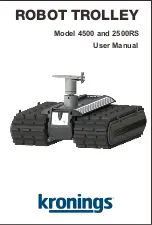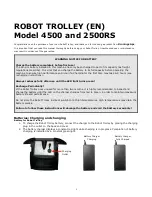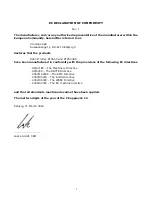
Mounting of Robot Trolley
1.
When mounting the Robot Trolley on the suspension fitting, adjust the height of the suspension fitting using the
nose/jockey wheel.
2.
The suspension fitting mounted on the Robot Trolley fits into a slit on the underside of the mounting fitting on the
left side (seen from the ball catch) and can be pushed into place in this slot.
3.
After pushing the Robot Trolley into the slot in the mounting fitting, attach the factory-provided cotter ring, which
locks the Robot Trolley in place.
4.
After attaching the cotter ring to the Robot Trolley, raise the support wheel to its highest position, and release the
hand brake. This shifts the weight of the caravan onto the Robot Trolley. You are now ready to tow your caravan.
Illustration of the Robot Trolley mounted on the side
members of the caravan:
VARIANTS
RT4500 and RT2500RS models are equipped with low
tower with ball joint
Low tower for RT4500 and RT2500RS
Using the Robot Trolley
SOME ADVICE ON SAFETY AND OPERATION BEFORE STARTING
1.
Familiarize yourself with the operating manual, and practice maneuvering the caravan on a flat surface before
attempting to maneuver it on sloping surfaces. We recommend testing your Robot Trolley at home
–
also
without a caravan
–
so you can try out the different maneuvering options.
2.
Load:
The Robot Trolley is designed for moving caravans weighing up to approx. 4500 kg (Model RT4500) and
2500 kg (Model RT2500RS). In order for Robot Trolley to function optimally, the ball weight must be at least
75-85 kg. This ball weight creates about 120-150 kg of pressure on the Robot Trolley. Too little weight on the
Robot Trolley may result in poor gripping and poor towing results. Greatest pressure is achieved by mounting
the Robot Trolley as far back on the side members as possible.
3.
Level surfaces:
To ensure optimal transfer of the Robot Trolley
’s power to the surface it is to operate on, the
Robot Trolley must move in the direction of the antenna, i.e. forward. (Except on sloping surfaces, see below).
4.
Sloping surfaces:
Operating the Robot Trolley on sloping surfaces may shift and decrease the pressure on the
Robot Trolley, resulting in poor contact with the terrain.
o
When using your Camper-Trolley to move your caravan or trailer UP a slope or edge, the CT must PUSH
the caravan up the slope
–
if necessary, one wheel at a time. Optionally, use a ramp.
o
When moving your caravan DOWN a slope the CT must LEAD the caravan DOWN the slope.
ATTENTION: If going downhill, it is very important that the Robot Trolley is turned 180 degrees, so that it
is moving in reverse, down the hill, i.e. with the antenna opposite the maneuvering direction and facing
the caravan. This is important, as the Robot Trolley might otherwise tip over forward.
Special precaution
5.
Be aware that if towing down very steep inclines or on wet, oily surfaces, it may be necessary to use the hand
brake on your caravan during operation if the Robot Trolley is unable to hold the caravan or the caterpillar
tracks cannot adequately grip the surface.
6









